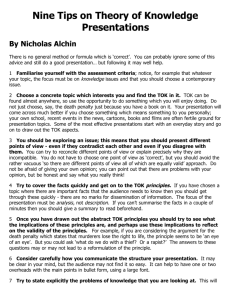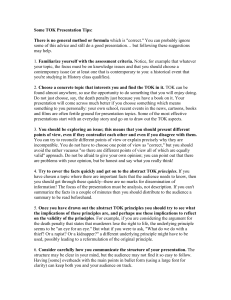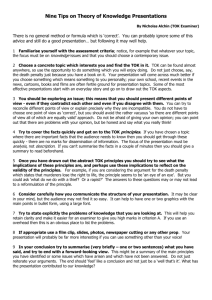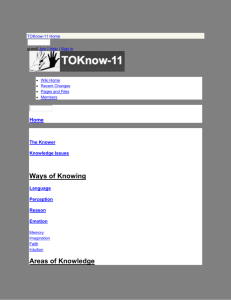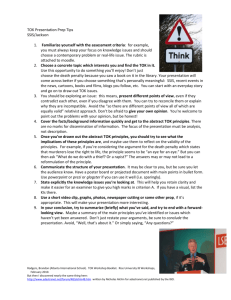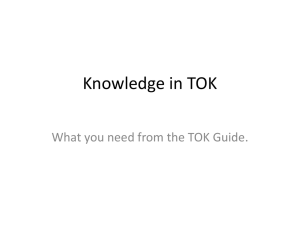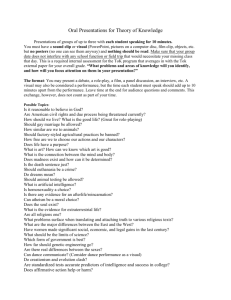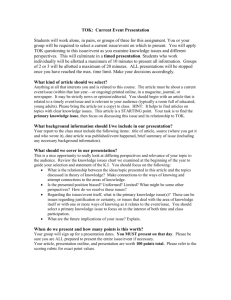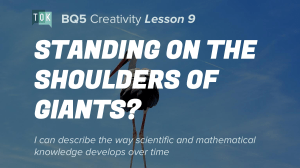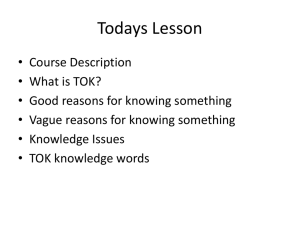What is the Objective of TOK Presentation?
advertisement
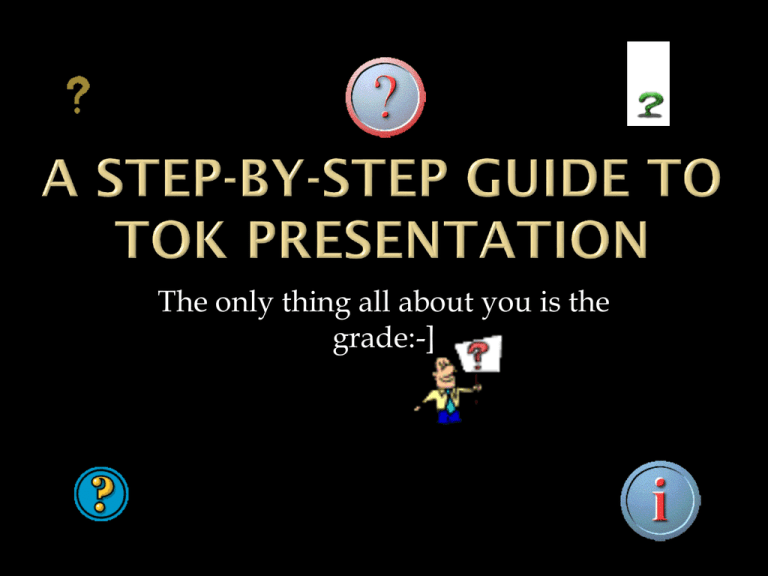
The only thing all about you is the grade:-] Critical Analysis Addressing two fundamental questions: What it is I claim to know? How valid are the methods used to establish what it is I claim to know? • Assess and Evaluate: • • success, controversy and failure of the methods used to try and explain: 'How we know what we claim to know’ Critical questions on a whiteboard; Worksheet with critical questions; Newspaper Article with critical questions; Power Point presentation with critical questions; Watch a section of a film/DVD followed with a critical analysis; Perform a social experiment followed with a critical analysis; Perform a role play to highlight a critical analysis; Perform a good piece of music and then a bad piece to investigate what supposedly gives it its quality; In pairs deliver and highlight the opposing views of debate; Create your own (with my approval prior to beginning) FOR PAIRS – break your presentation up into points one person speaking first, then the other, and alternating through the presentation: like a game of tennis. Speak for equal amounts of time (Your marker is grading both of you) FOR ALL – Always have your presentation planned Have main points in front of you DO NOT write an essay to read aloud DO NOT read a Power Point Presentation Boring! Waste of Time! Tell the audience what they need to know and then lead them straight into the analysis. Research: Obviously you will need to know a certain amount on the topic – but don't do too much – sometimes reading one newspaper article can be enough – as the focus is on your analysis and the critical questions: 1. What is claimed? 2. What methods were used to reach that conclusion? 3. How valid are those methods? 4. Do these methods work in other Areas of Knowledge? 5. What still puzzles you? 6. What methods/evidence would you need to accept their claim? 1. Familiarize yourself with the assessment criteria. a. b. c. All topics must focus on knowledge issues All topics must be a contemporary issue for YOU (or at least one that is contemporary to you: a historical event that you're studying in History class qualifies). 2. Choose a concrete topic that interests you and find the TOK in it. TOK can be found almost anywhere, so use the opportunity to do something that you will enjoy doing. a. b. c. Do not just choose the death penalty just because you have a book on it. Choose something personal: your own school, recent events in the news, cartoons, books and films Start with an everyday story and go on to draw out the TOK aspects 3. Explore the issue = present different points of view even if they contradict each other, even if you disagree Reconcile different points of view or b. Explain precisely why they are incompatible c. THE “correct" way is not necessary d. But avoid the rather vacuous "so there are different points of view all of which are equally valid” e. Give your own opinion; you can point out that there are problems with your opinion, but be honest and say what you really think! (Criterion B: Knower's Perspective) a. 4. Try to cover the facts quickly and get on to the abstract TOK principles. a. b. c. If you have chosen a topic where there are important facts that the audience needs to know, get through these quickly--no marks for dissemination of information! The focus of the presentation must be analysis, not description. If you can't summarize the facts in a couple of minutes, distribute to the audience a summary to be read beforehand. 5. Once you have drawn out the abstract TOK principles, you should try to see what the implications of these principles are, and perhaps use these implications to reflect on the validity of the principles. a. b. For example, if you are considering the argument for the death penalty that states that murderers lose the right to life, the underlying principle seems to be "an eye for an eye." But what if you were to ask, "What do we do with a thief? Or a rapist? Or a kidnapper?" a different underlying principle might have to be used, possibly leading to a reformulation of the original principle. 6. Consider carefully how you communicate with the structure of your presentation. a. b. The structure may be clear in your mind, but the audience may not find it so easy to follow. Having one or two ppt slides with the main points in bullet form (using a large font for clarity) can keep both you and your audience on track. 7. State explicitly the knowledge problems in topic a. b. Helps with clarity and makes it easier for an examiner to give you high marks in criterion A (Knowledge Issues). If you use an overhead, list the problems there. 8. If appropriate use a film clip, slides, photos, newspaper cutting or any other prop. Your presentation will probably be far more interesting if you can use something other than your voice! b. But make sure that the props serve a specific purpose, and that they don't replace the analysis that will earn you high marks in criterion B (Quality of Analysis). a. 9. Conclusion Summarize a. • Forward-looking view b. • c. Main principles previously identified Some issues that may not have been answered Should feel like an end; not like a “that’s all folks!”
